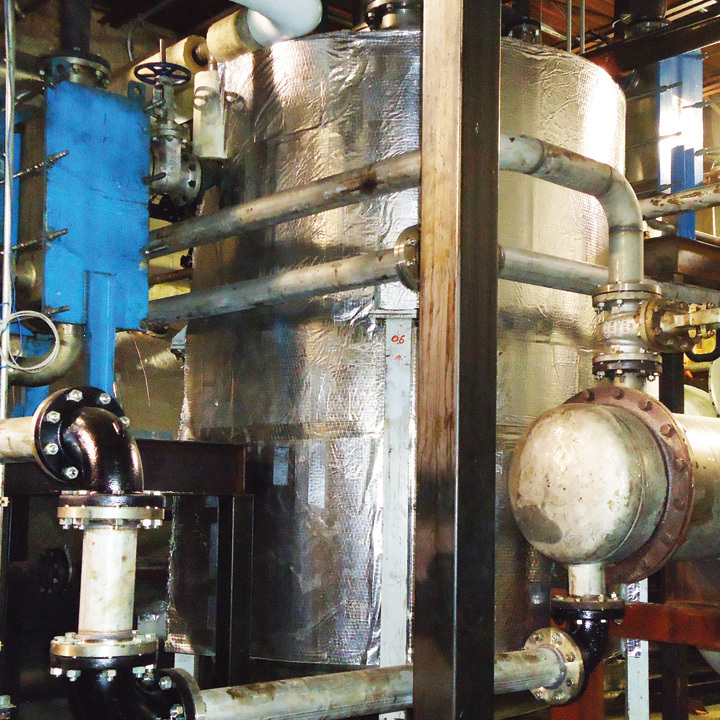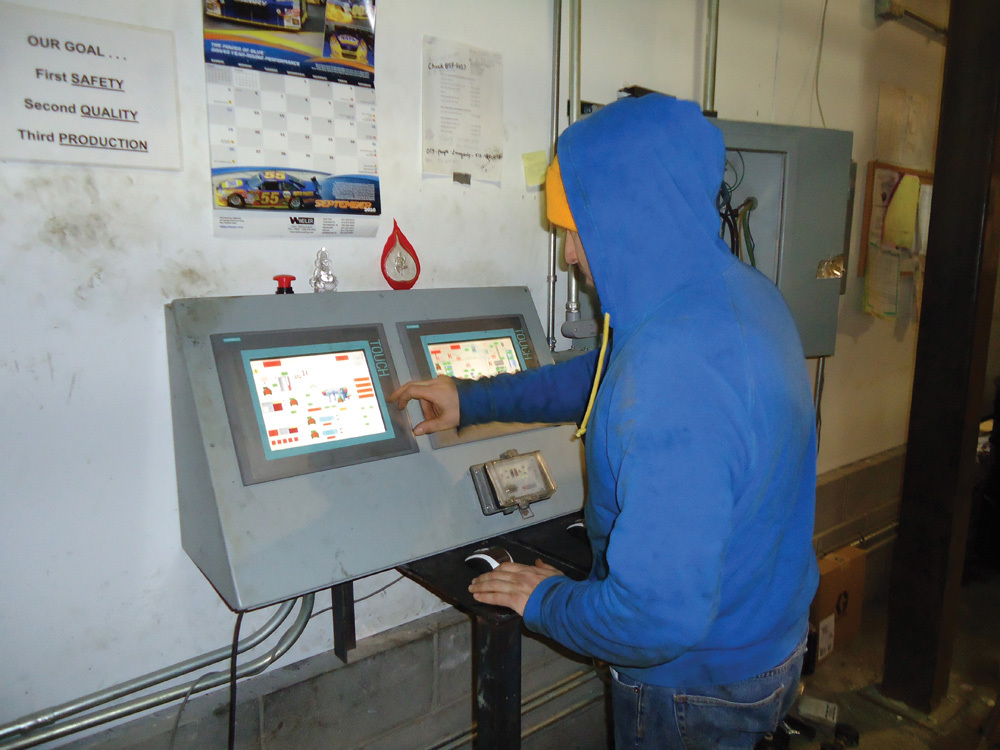Homogenous Catalyst and Effects on Multifeedstock Processing



PHOTO: JATRODIESEL INC.
May 13, 2011
BY Raj Mosali and Sharath Bobbili
Biodiesel is currently produced via transesterification of triglycerides with an alcohol such as methanol. The transesterification of triglycerides comprises of three sequential, reversible reactions wherein triglycerides react to form diglycerides, monoglycerides and glycerol. On a side note, it is important for one to know the triglyceride content of the oil when purchasing.
Traditional biodiesel processing is comprised of two broad categories: esterification (or a variation of it such as glycerolysis, enzymatic or temporary solid catalysis) and transesterification. The traditional esterification process uses methanol with a homogenous acid catalyst such as sulfuric acid to convert free fatty acids (FFAs) into esters. Traditional transesterification uses a homogenous base catalyst such as sodium methylate or potassium methylate along with methanol to convert to the triglycerides into biodiesel and glycerin.
The point of discussion for this article is traditional homogenous catalyst such as sulfuric acid, and sodium or potassium methylate, and their drawbacks as applicable to variable FFA material in a multifeedstock environment.
In a very low FFA (less than 1 percent) feedstock environment, catalysts such as sodium or potassium methylate make good sense, but in a high FFA environment, one starts to encounter various issues with these catalysts.
The Catalyst
A catalyst is a chemical that helps speed up the chemical process without actually participating in it. How a homogenous catalyst such as sulfuric acid or sodium methylate differs in this is also an important part of the discussion.
There are two kinds of catalysts typical to any biodiesel process: homogeneous and heterogeneous. Homogeneous catalysts function in the same phase (liquid, gaseous, etc.) as the reactants. Typically, homogeneous catalysts are dissolved in a solvent with the substrates. Heterogeneous catalysis is the opposite of homogeneous catalysis, meaning it occurs in a different phase than the reactants. Most heterogeneous catalysts are solids that act on substrates in a liquid or gaseous reaction mixture. Diverse mechanisms for reactions on surfaces are known, depending on how the adsorption takes place. The total surface area of solid has an important affect on the reaction rate; the smaller the catalyst particle size, the larger the surface area for a given mass of particles.
Homogeneous catalysts for biodiesel production have been around for quite some time, but heterogeneous catalyst is a fairly newer development in the realm of biodiesel production.
Typically sulfuric acid is used as the homogeneous acid catalyst for the esterification of FFAs. Sometimes though, hydrochloric acid is also used.
Reaction
An ester can react with another alcohol. In that case, the new alcohol is derived from the original ester formed, and the new ester is derived from the original alcohol. Thus, an ethyl ester can react with methanol to form a methyl ester and ethanol. This process is called transesterification.
Transesterification is extremely important for biodiesel. Biodiesel as it is defined today is obtained by transesterifying the triglycerides with methanol. Methanol is the preferred alcohol for obtaining biodiesel because it is the cheapest, and most available, alcohol. For the reaction to occur in a reasonable time, however, a catalyst must be added to the mixture of the oil and methanol. Often present in small amounts, catalysts accelerate the speed of a reaction and, in many cases, virtually no reaction would occur without one.
The catalyst used for carrying out transesterification is usually sodium hydroxide (NaOH) or potassium hydroxide (KOH) or sodium methylate (SMO). These compounds belong to a class of materials known as bases and also are inorganic compounds, often used in organic chemistry for carrying out or catalyzing reactions. Other bases are also suitable for the transesterification reaction. The counterparts of bases are known as acids. Many acids can also be used as catalysts for transesterification. However, the base-catalyzed reaction has advantages such as a higher reaction rate.
Advertisement
A fatty acid and base react to form a new compound, called soap and water. Compounds such as soap, in which the hydrogen (proton) of an acid has been replaced with a metal ion, are often called salts.
The reason that such compounds exist is that materials such as NaOH or KOH can split apart, or dissociate, in a fashion that gives Na+ and OH- (or K+ and OH-) in which the protons and electrons are not evenly distributed, leading to charged particles. Thus, having the same charge, Na+ or K+ can replace H+ here.
The Process
The most common homogenous catalysts used in the biodiesel production is sulfuric acid during esterification and sodium methylate during transesterification. Typical biodiesel processing that involves high FFA oil is comprised of two steps, esterification and transesterification. During esterification, a predetermined quantity of sulfuric acid based on the FFA content of the oil being processed, is added to oil with high FFA and methanol. There are various ways of processing esterification, at atmospheric pressure and 65 degrees Celsius to 70, or under high pressure and high temperatures, etc.. The important byproduct of esterification process is water, which dilutes the catalyst thereby hindering in the esterification process.
One of the points to note here is transesterification also occurs in the presence of sulfuric acid apart from esterification. Repeated experiments by various researchers show a majority of transesterification would have occurred by the time esterification has reached its equilibrium.
After reducing the FFA of the oils through the esterification process to less than 1 percent, the oil goes into the transesterification phase. Another point of interest here is that some technologies do recommend going straight into transesterification if the feedstock FFA content is less than 4 percent. The downside to this, however, is that there would be a lot more usage of catalyst. It also results in substantial product loss due to the formation of soap. Higher process costs are also possible, due to acid number issues that need to be fixed so the fuel can meet the ASTM D6751 specification.
During transesterification, once the calculated amount of catalyst (SMO) and required amount of methanol is dosed into the reactor, the process would not change whether using batch or continuous, the temperature is maintained around 65 degrees Centigrade. The reaction kick starts.
At the same time when the triglycerides are converted to diglycerides and monoglycerides, the FFAs are converted to soaps. The higher the FFA content is when starting, the greater production of soap there will be. Almost 90 percent of the soap goes into the glycerin phase in the settling process or centrifuging. Contrary to some of the claims out there, to completely eliminate soaps before water washing or dry-wash step is nearly impossible.
There is also some residual homogenous catalyst left over from the biodiesel process, which has to be removed in the washing stage as well.
Potential issues with high FFA feedstock processing using the traditional homogenous catalyst include higher acid number, yield losses, higher post-cleaning processes, quality of glycerin, product consistency, and process consistency due to changing starting FFAs. If proper care is taken and quality is monitored, these issues can be addressed.
Advantages and Drawbacks
There are some advantages and some drawbacks to using homogeneous catalyst such as sulfuric acid or SMO in the variable FFA materials, especially those with high FFA content and multifeedstock product.
Due to the general availability of the products, the price is fairly competitive and there are little issues with product supply.
Advertisement
Another advantage of the homogenous catalyst is its usability. Since the operations occur in the same phase as your reactants, the handling becomes that much easier. Handling all liquids is easier than handling one liquid and one solid or a combination of them.
Some of the drawbacks of using the homogenous catalyst for biodiesel production are:
1) Water formation during acid esterification hinders the process. Care should be taken to get rid of water via drying, and this adds to the cost.
2) Reusability—though there are claims of reusing the catalyst, it’s rarely seen if ever done on a production scale, due to the costs involved.
3) Corrosive nature of the catalysts involved. The popular acid (H2SO4) and base (SMO) catalysts currently used in the biodiesel production process are fairly corrosive in nature and need to be handled extremely carefully.
4) The SMO tends to absorb water and needs to be under a nitrogen blanket. For shorter storage durations or when the liquid has short turnaround, blanketing can be avoided. As always, plan for the worst in a production environment so you are not caught flatfooted.
5) SMO tends to settle and potentially lose its original power over a period of time if unused and sitting. The related troubleshooting and fixing is extremely time-consuming and expensive.
6) Multiple stages of processes (multi-stage esterification, and multi-stage transesterification).
7) With multiple stages involved, there is loss of heat, transfer time, wear and tear and employee training time to address all processes.
Where is the Industry Going?
The heterogeneous, enzymatic and other kinds of catalysts are picking up in the market with some of the major developments coming in the past year. With continued developments and improvements, the cost and operational advantages a recyclable heterogeneous catalyst would provide will outweigh the homogenous catalyst.
Numerous companies including Jatrodiesel have developed heterogeneous catalysts that are recyclable and provide a tremendous cost and operational advantage to the customer.
With more and more feedstocks coming online such as pennycress, algae and other potentially high-volume feedstocks with variable FFAs and characteristics, the process and the associated catalysts should be ready for the challenge. Will the homogenous catalyst still be the norm in future? Time will tell.
Authors: Raj Mosali , Sharath Bobbili
President, Refinery Deployment Manager, JatroDiesel Inc.
(937) 847-8050
rmosali@jatrodiesel.com
Upcoming Events





